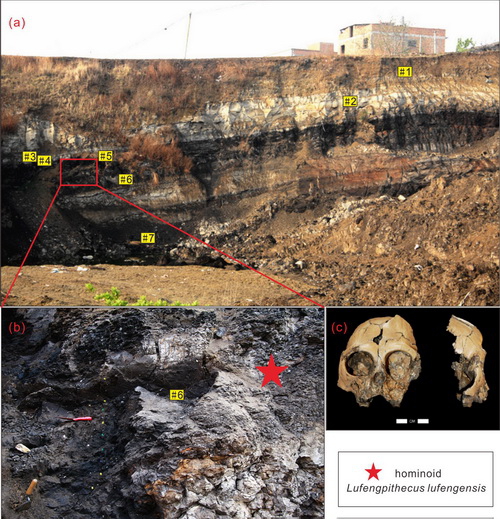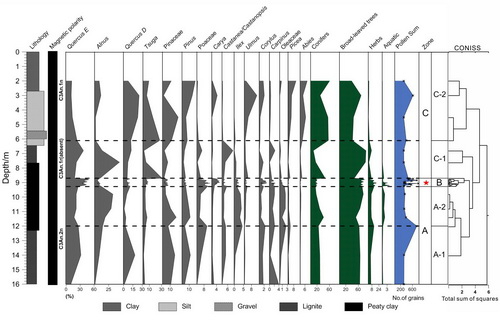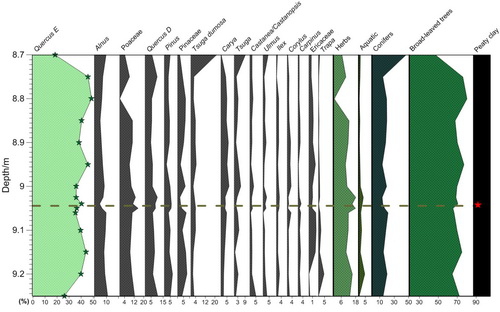Evolutionary processes in hominoid primates are closely related to global and/or regional environmental changes and palaeoenvironmental reconstructions are fundamental for understanding how environmental changes shaped their evolution.
Following their appearance in Africa around the Oligocene/Miocene boundary (23 Ma), various hominoid species lived in Africa, Europe and Asia during the Miocene, but with an uneven temporal and spatial distribution. Notably, there appears to have been a flourishing of hominoid species in parts of East Africa and Europe around the mid-Miocene Climate Optimum (17–15 Ma). However, in the late Miocene (approximately 11.6–5.3 Ma), the number of ape taxa decreased sharply worldwide and they became rare in Africa and parts of Asia. In Europe, hominoids became extinct after the Vallesian Crisis of the earliest Late Miocene, with the latest recorded in the Vallès-Penedès Basin, Spain at around 9.5 Ma, or at Rudabánya, Hungary, at ca. 10–9.7 Ma. It is noteworthy that the southeastern margin of the Tibetan Plateau, particularly in Yunnan, southwest China, served as an important refuge for the late Miocene hominoids (Fig. 1).
Recently, a new hominoid fossil (Fig. 2) was discovered in the Shuitangba (STB) section, Zhaotong Basin, northeastern Yunnan, which was assigned to the species Lufengpithecus lufengensis and magnetobiostratigraphically dated at ~6.2 Ma – the end Miocene. It is the youngest Miocene fossil ape to be discovered (Ji et al., 2013). The end Miocene was a critical time interval for mammalian evolution, especially for the evolution of the apes and early humans. Climatic and environmental changes as well as tectonic processes during this critical period had a profound influence on their habitats, and thus may have led to important evolutionary events. For example, a marked change in palaeovegetation, especially an expansion of grasses, has been widely documented around the world in the late Miocene and Pliocene. During this period, the divergence of ape and human lineages occurred in Africa and apes disappeared in Europe and later became extinct in East Asia.
Doctoral candidate CHANG Lin and her supervisor Prof. GUO Zhengtang and Prof. DENG Chenglong with their team at the Institute of Geology and Geophysics, Chinese Academy of Sciences (IGGCAS), have carried out a detailed palynological investigation on the STB sedimentary sequence, which enabled them to reconstruct the vegetation and environmental conditions during the period when the STB hominoid lived. Their results show that during the period when the hominoid was present (Zone B, Fig. 3,4), evergreen broad-leaved forests with evergreen Quercus were predominant, while grasses, including Poaceae, began to expand. At the same time, conifers decreased, all of which indicates a warm climate. The significant presence of aquatic pollen taxa in subzone A-2 (Fig. 3) and Zone B suggests the occurrence of lacustrine or swampy environments. In contrast, after the disappearance of the STB hominoid (Zone C, Fig. 3), the vegetation changed to coniferous forest, which indicates cooler and drier conditions. These provide substantive evidence of the vegetation conditions when the hominoid lived and suggest that the greater diversity of vegetation and the warm humid climate, compared to the present day, would have favored its survival.
Compared with the palaeoenvironment and vegetation of Africa and southwestern China in the late Miocene, the landscape of Africa, especially East Africa, has been significantly reshaped over the last 10 million years, changing from a relatively flat, homogenous region covered with mixed tropical forest, to a varied and heterogeneous environment. At that time, very arid conditions, evidenced by sparse tree cover, occurred over the entire tropical region. From a comparison of fauna from 5 sites in Yunnan, where the late Miocene hominoids lived, it is clear that the palaeovegetation present alongside the hominoid Lufengpithecus gradually evolved from dense forest to relatively sparse mixed forest and woodland. These changes could have been caused by the episodes of uplift in the southeastern margin of the Tibetan Plateau and/or lateral movements along major fault systems, which would have isolated the hominoids geographically and ecologically.
This research was published in the international journal Palaeogeography, Palaeoclimatology, Palaeoecology (Chang et al. Pollen evidence of the palaeoenvironments of Lufengpithecus lufengensis in the Zhaotong Basin, southeastern margin of the Tibetan Plateau. Palaeogeography, Palaeoclimatology, Palaeoecology, 2015, 435: 95–104) (Link)

Fig. 1. Schematic map of the principal late Miocene hominoid-bearing sites in Yunnan Province (a). Also shown in (b) is the Zhaotong Basin and its major fluvial system.

Fig. 2. Photographs showing the studied STB section. (a) Terrain of the Shuitangba section, which is located in an open-pit lignite mine in the Zhaotong Basin. The numbers represent the sedimentary units (see Table 1 for lithology); (b) a close-up view of the black peaty layer showing the location of the STB hominoid cranium, which is also shown in (c) and is described in detail by Ji et al. (2013).

Fig. 3. Pollen diagram for the Shuitangba section (depth interval of 0–16.00m). The diagram is divided into three zones and four subzones based on pollen assemblages and the results of cluster analysis.

Fig. 4. Pollen diagram of the hominoid-bearing layer (8.70–9.25 m).
Contact:
CHANG Lin
Division of Cenozoic Geology and Environment,
INSTITUTE OF GEOLOGY AND GEOPHYSICS CHINESE ACADEMY OF SCIENCES (IGGCAS)
E-mail: changlin@mail.iggcas.ac.cn